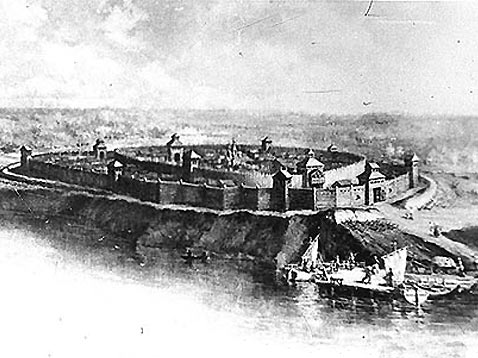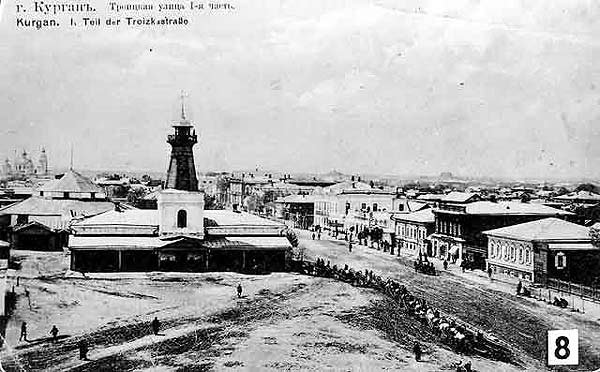Kurgan Region
History
Kurgan
is the Russian word of Turkic origin meaning a burial mound. Some
scholars think Kurgan culture reflects an early Indo-European ethnicity
which existed in the steppes and southeastern Europe from the V to III
centuries BC. On the Kurgan land there are many monuments of archaeology, which belong to various cultures and epochs. One of most known - the Tsarev Kurgan, which gave its name to the Kurgan city. There is the legend about Tsarev Kurgan: on the high shore of Tobola River, at the picturesque place, where the settlement Tsarevo Gorodische was established, in the old ages there was the yourtas of the famous Tatar Khan. Its daughter was a stunning beauty. But her life was broken when she was young. Father buried the dear daughter next to his dwelling, and above the grave he ordered to pour a high barrow. Once, through many years, hunters decided to ransack barrow. The Khans daughter didn't tolerate the disturbance of her rest. The pair of the white horses, charged into the silver chariot, was pulled out in summer midnight from the depth of the barrow and the Khan's daughter in the richest Tatar dress guided them. The dissolved hair volitated in air. Terrible and excellent girl dashed to the West and disappeared together with her chariot in the depth of the Chukhlomskoe lake. The first Russian populated area in the southern Beyond-Ural area became the Dalmat's
One of the most influencial facts in the history of the town is the
construction of the Trans-Siberian railway in 1894. The next important
step was receiving the status of the regional centre in 1943.
|
Visitors
Онлайн всего: 1 Гостей: 1 Пользователей: 0 |
 Kurgan was founded in 1662 as a village called Tsarevo Gorodishe on the Tobol River.
Kurgan was founded in 1662 as a village called Tsarevo Gorodishe on the Tobol River. monastery,
eastablished in 1644 by the monk Dalmat Ioannovich Mokrinsky. The
ancient manuscripts report that find under the patronage of Our Lady,
Dalmat avoided decease from the sword of the land's owner. This
uninhabited land belonged to notable Tyumen's tatar murz Iligey. In the
autumn of 1645 Iligey, after arriving with his people, stopped at the
right bank of the Iseti River in order to punish the russian monk after
crossing the river in the morning. But at night, when Iligey slept, the
holiest Our Lady appeared in his dream, and ordered murz to give to
Dalmat the entire land and to cause him no offence. In the morning
shaked Iligey arrived to Dalmat with peace and presented to Dalmat its
combat helmet and hauberkas as a sign of friendship, love and
respect. Considered wonder-working, they were stored in the Dalmatovsky Uspenski monastery for
more than 280 years. The peace principles of orthodox and islamic
people were stamped in the people consciousness for the centuries .
monastery,
eastablished in 1644 by the monk Dalmat Ioannovich Mokrinsky. The
ancient manuscripts report that find under the patronage of Our Lady,
Dalmat avoided decease from the sword of the land's owner. This
uninhabited land belonged to notable Tyumen's tatar murz Iligey. In the
autumn of 1645 Iligey, after arriving with his people, stopped at the
right bank of the Iseti River in order to punish the russian monk after
crossing the river in the morning. But at night, when Iligey slept, the
holiest Our Lady appeared in his dream, and ordered murz to give to
Dalmat the entire land and to cause him no offence. In the morning
shaked Iligey arrived to Dalmat with peace and presented to Dalmat its
combat helmet and hauberkas as a sign of friendship, love and
respect. Considered wonder-working, they were stored in the Dalmatovsky Uspenski monastery for
more than 280 years. The peace principles of orthodox and islamic
people were stamped in the people consciousness for the centuries .  Kurgan got the status of a city in 1782 under Empress Ekaterina. The
population of the town at that time was about 2 thousand people. Up to
the end of XIX century it developed slowly, serving mostly as the place
of exile. In 1913 the population of the town was 30 thousand people, in
1957 it reached 147 thousand and in 1998 it was about 374 thousand
people.
Kurgan got the status of a city in 1782 under Empress Ekaterina. The
population of the town at that time was about 2 thousand people. Up to
the end of XIX century it developed slowly, serving mostly as the place
of exile. In 1913 the population of the town was 30 thousand people, in
1957 it reached 147 thousand and in 1998 it was about 374 thousand
people.